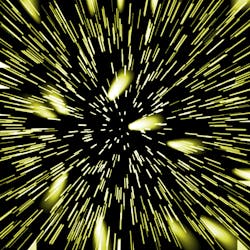Fiber’s sensitive and quantum future
Quantum simultaneously threatens to upset decades of cybersecurity and provide the solution for more secure networks.
Fiber is best known for delivering vast amounts of data, with trillions of photons of light adding up to terabytes of data per second. However, the same technology will become increasingly crucial in simultaneously transporting a single pristine photon to enable quantum applications in security, sensing, and computing.
Quantum is a business that simultaneously threatens to upset decades of cybersecurity and provide the solution for more secure networks for decades.
Transmitting data to collecting data
Fiber optic cable is a multi-use technology that delivers data and provides additional and unique sensing capabilities by measuring the properties of the light traveling inside it. Initially envisioned as a simple add-on for monitoring cable health, such as detecting someone digging nearby, a wealth of information has become available for infrastructure usage and health, environmental monitoring, and even astronomy.
Existing, placed fiber optic cable can be used to analyze vehicle traffic, including vehicle size, direction, speed of travel, temperature changes in the air, and even sound vibrations ranging from gunshots and potholes to the buzzing of cicadas. Fiber on bridges can measure stresses and strains of the structure as well as count the number and type of vehicles that go across. The wealth of fiber deployed worldwide is also being measured up for a high-precision tool to detect, monitor, and image the processes of earthquakes.
Fiber is also being used to find new energy sources in remarkable ways. In the Imperial Valley Dark Fiber Project, existing dark fiber is being used to map and monitor geothermal resources, using seismic measurements to build larger, more detailed subsurface maps without the labor-intensive and capital-expensive deployment of dedicated sensors. Teaching two old dogs a new trick, Fervo Energy is installing fiber into its geothermal wells, enabling it to gather and analyze real-time data on flow, temperature, and performance. Google uses Fervo’s first geothermal project to power its Nevada data centers with carbon-free electricity.
For sensing the world around us, dark and lit fiber are relatively untapped resources that will provide dividends far into the future as we learn to use them better and more widely. Undoubtedly, more unique applications will be developed in the years to come by measuring the quality of light flowing through the millions of miles of data-carrying fiber distributed throughout the world above and below ground.
Preventing the “Cryptocalypse”
Today’s modern economy is built around public critical infrastructure (PKI) and algorithms developed in the late ‘80s and continually enhanced as computers became faster at encoding and decoding information. Based on one-way functions and prime number factoring, PKI and other cryptography systems are increasingly vulnerable to being broken by quantum computing systems.
When will quantum computing become helpful enough to break the current regime of modern encryption, often called the “Cryptocalpse?” Estimates vary from three to five years at the earliest to most assuredly sometime in the next 15 years. It’s not a matter of whether a quantum computer can be built but how fast a large enough quantum computer can be built to shatter existing encryption schemes.
In its “Quantum Computing and Post-Quantum Cryptography FAQs,” published in 2021, the U.S. National Security Agency said, “the impact of adversarial use of a quantum computer could be devastating to [National Security Systems] and our nation.” The algorithm to crack today’s encryption was developed in 1994. Researchers worldwide are examining ways to improve and create more efficient ones by leveraging the power of quantum computing.
The United States and other countries are steadily working to prevent the Cryptocalypse, with the National Institute of Standards and Technology (NIST) charged with soliciting, evaluating, and standardizing one or more “quantum-resistant” public-key cryptography algorithms to replace existing PKIs. Developing and implementing solid algorithms across the modern PKI infrastructure could take up to two decades, based on how long it took to build and deploy the existing technologies.
However, solutions are already being taken to implement more secure networks based on quantum technologies. Quantum key distribution (QKD) is being implemented today in Asia and Europe. It provides a way to securely deliver cryptographic keys with key bits securely encoded at the single photon level. Each photon is sent over a fiber link. Quantum mechanics guarantees that any eavesdropper observing one or more photons will change the information encoded, so no attacker can copy, clone, or read the information.
Skeptics will argue that it’s easier and cheaper to roll out quantum-resistant algorithms in the form of software updates than to implement a QKD infrastructure requiring a dedicated fiber link and associated hardware. Software and algorithms may have baked-in vulnerabilities that will only be revealed over time and by the efforts of bad actors. QKD presents a practical, off-the-shelf security option available for implementation today for enterprise institutions, regardless of how soon the post-quantum era arrives.
Sensing everything better
Built around the delicate nature of a single photon, quantum sensors are being imagined, designed, and assembled for high-sensitivity applications such as early cancer detection biological process mapping that could lead to a whole-body scan without the lengthy and claustrophobic experience of an MRI; improved geological understanding that could lead to accurate prediction of earthquakes and discovery of resources; and quantum radar to accurately see in pitch dark and under all weather conditions.
Quantum sensors provide unprecedented resolution and sensitivity to detect such characteristics as magnetic fields, electric fields, temperature, pressure, gravity, and chemical composition. Applied to medical applications, quantum sensors can measure activity to the scale of individual proteins and cells. Already, quantum sensors are providing new insight into brain and heart activity, enabling the study of brain injury and disorders without cumbersome cryogenic cooling.
Closer to telecommunications, room temperature quantum sensors will broaden the range of wavelengths that can be detected, expanding both the range and potential bandwidth for next-generation fiber optic communications equipment supporting both quantum and conventional communications, as well as light-fast optical-electronic systems to help the torrent of data streaming down a single strand of fiber. Petabyte speeds, anyone?
Connecting quantum computers
Networking quantum sensors and quantum computers on a large scale represents a significant technological challenge that will provide benefits we can only begin to imagine. Today’s early-stage quantum networks move around photons on a scale of tens of kilometers, with the first commercial quantum network in Chattanooga, Tennessee, providing a testbed for companies to build, test, and refine the commercialization of quantum technologies, including equipment and software.
The ultimate goal of long-distance quantum networking is to enable the connection of quantum computers across the country and around the world to solve previously unsolvable programs in materials science, drug development, astronomy, and large-scale sensing. The Department of Energy has published a report outlining the construction of a nationwide “Quantum Internet” and the scientific and engineering challenges to build such a network over the next decade.
The Quantum Internet would provide the framework to measure gravity waves more precisely, sharpen imagery, build distributed clusters of quantum computers, and provide much more secure communications. Building this national network will require developing technologies that marry the best of existing classical network technologies and can move quantum information around without disturbing it. Building quantum switches, multiplexers, memory buffers, and repeaters and integrating them represent significant challenges, especially in moving from laboratory benches into the large numbers of commercial off-the-shelf hardware needed for a national network.
Sensing and quantum technologies represent the exciting and boundless future of fiber optic networks, with fiber providing the unique ability to be used in new and innovative ways far beyond the function of moving the large amounts of data that drive our economy, entertainment, security, health care, education, and cellular connections over the past decades. It’s a benefit to fiber networks that will continue to yield dividends in the decades.
Gary Bolton is president and CEO of the Fiber Broadband Association — the largest trade association dedicated to all-fiber-optic broadband. Before FBA, Gary held executive management positions in marketing, product line management, and public policy at two successful venture-backed high-tech start-ups and large publicly traded companies. Gary is also an adjunct business administration and management science professor at the University of Alabama in Huntsville. He holds an MBA from Duke University and a BS in Electrical Engineering from North Carolina State University.

